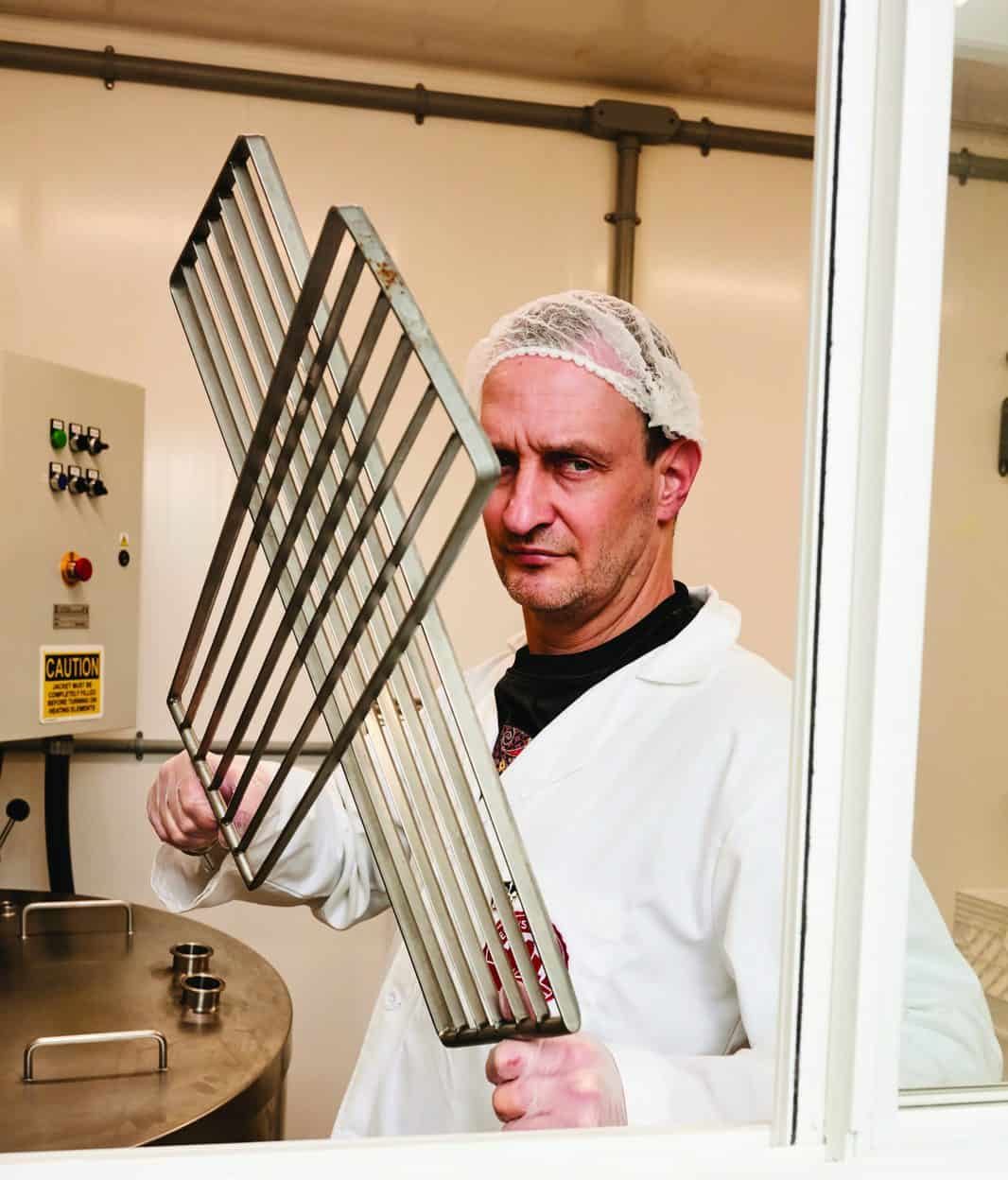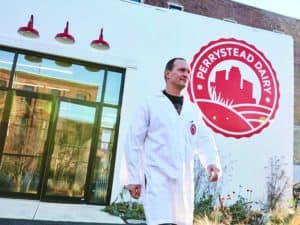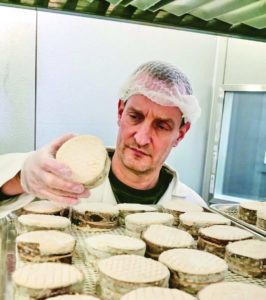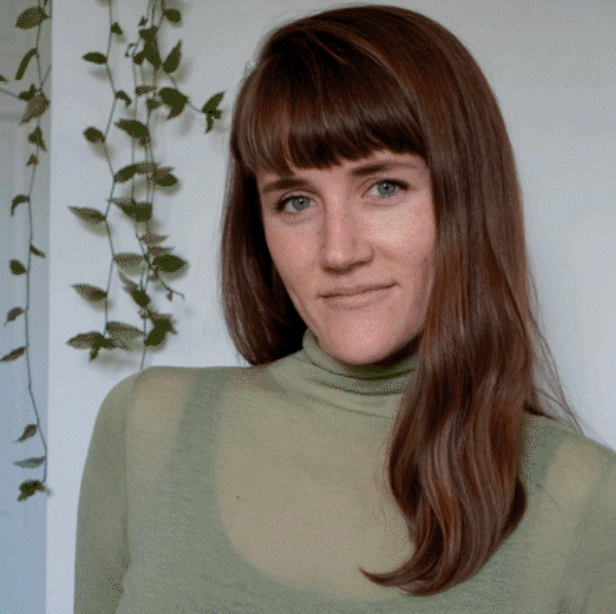
Photographed by Juan Chami
American cheese—a phrase most of us grew up associating with bendy squares in plastic wrappers. Even as our country’s cheese scene has ballooned, riffs on the Old World tend to dominate all the way from the Green Mountains to Tomales Bay. But in Philly, one ambitious cheesemaker thinks we have what it takes to step out on our own. His name is Yoav Perry.
Perry got his start in the industry as a hobbyist cheesemaker, but he quickly tired of replicating old standards. What began with ordering hard-to-find cultures, rennets, and molds for his own experiments soon turned into a consultancy, and eventually he found himself supplying hundreds of makers around the globe. Business was good, but he still wanted to create one-of-a-kind cheeses—a wish granted in March 2021 with the opening of Perrystead Dairy in Philadelphia’s Kensington-Fishtown corridor.
The model for Perry’s urban cheesemaking project was simple: bring excellent milk from the country to the consumers, distributors, and restaurants in the city, paying farmers top dollar while saving them the added risk and expense of cheesemaking. With the help of a grant from the state of Pennsylvania, he equipped a dingy industrial building with a retrofitted shipping container optimized for cheesemaking and hit the ground running. He’s garnered so much media attention he can barely keep the cases full, but he took some time away from the lab to chat with us about his process.
This interview has been edited for length.
culture: Ok, I like to begin by asking people how they stumbled into this wild world of cheese!
YOAV PERRY: I’ve been obsessed with cooking and fermentation since childhood. My parents spent years in France before I was born. Our Francophile cheese-positive household was one where Camembert spent some days outside the fridge first to age it “just right.” At one point I wanted to make yogurt without the junk for myself, and never thought of fermenting milk as anything different than pickles or sourdough or cured meats. I was stunned by what I saw in bacterial cultures. Being Israeli, I figured, I’ll strain the yogurt to make labneh. That was my gateway drug to try rennet and classic cheese formulations. This magical metamorphosis was like a color-blind painter discovering [the] color palette for the first time. I fell in love with it.
How did you make the leap from importing cheesemaking supplies for yourself to starting an importing business?
YP: Inspired by things I’ve seen in Europe, I was obsessively immersing myself into complex cheesemaking, but the tools and ingredients in the U.S. at the time were very limited. I knew sourcing and importing, but high minimums and international shipping costs were prohibitive. So, when I found interesting cheesemaking items, I would ask fellow makers and message board members, “Who wants to go in on it with me?” The response was overwhelming. I realized that instead of opening a creamery in NYC, where numbers wouldn’t add up, I actually accidentally created a cheese business. Three years in, we had a fulfillment center and supplied over 700 makers in 30+ countries.
In another life, you worked in design for NYC tech start-ups. How does that skillset inform what you do now?
YP: Design is powerful. If you think of it, design is the formation of an object, process, or system to satisfy technical, aesthetic, or philosophical objectives. This is true [of] all design disciplines, whether it’s graphics, fashion, digital interface, or interiors. Cheese is no different. It’s subject to design. A maker must figure out the components of value to your consumer while staying within your philosophical bounds and a practical production system.
You’re known for your knowledge of the complicated science behind cheesemaking. At the same time, you’re super passionate about making cheese less esoteric and more welcoming. How do you reconcile these two things? In what ways have you tried to make the science more approachable, or the cheeses more consumer-friendly?
YP: Humans have been making cheese for millennia, before anyone knew what enzymes or bacteria are. Obviously, it was good enough to thrive through generations. Cheese is a sensory, experiential, organoleptic product. You connect to it through flavor, aroma, texture, appearance. At the end of the day, cheese science is merely a tool in a maker’s box. Just as color theory or music theory can help painters and musicians in making better art that resonates, it’s just a matter of vision, understanding the components of a creation that people really love, and the skill to put it together. Always lead with flavor. Only allow science that enables you as a performer.
You’ve incorporated one of my favorite cheesemaking techniques into your Intergalactic, coagulating the milk with cardoon thistle, which has origins in ancient Sephardic Jewish cheesemaking. I’m curious how you get your ideas, what’s your process for dreaming up anew cheese? And what cultures or practices are you currently feeling inspired by?
YP: For me, cheese must be absolutely delicious and very approachable first and foremost, but I also want it to tell a bigger story that puts the product in context. For example, when Jews were kicked out of the Iberian Peninsula in the Spanish Inquisition,[they] lost touch with their beloved thistle rennet.
Later on, they were kicked out of cheesemaking guilds in Europe purely for their bloodline. As a Jew, son of a Holocaust survivor, and grandson of a victim, the freedom to bring thistle back to Jewish cheesemaking 500 years later in America is a meaningful expression of my heritage, but it only works if people actually enjoy the cheese. Generally, I think of the milk as a blank canvas, then I work my way using what’s available to me to create something that’s fun, organoleptically delightful, and meaningful. Will it work with mushroomy or sulfury notes? Should it be crumbly or supple? Does a rind need to be brainy and dissolve in your mouth, or a fissured kaleidoscope of colors from which the creamline wants to ooze? For our Intergalactic, it’s lactic-coagulated thistle rennet with geo rind. Our Rocketman is a bloomy with a big top-center moon-like crater. It is coagulated with both thistle and French calf rennets and is super silky and garlicky. Our Atlantis is washed in local seawater from the Atlantic, infused and finished with several local seaweed species. They carry umami glutamine. None of this is rocket science. It’s just having fun and trying lots of things, most of which fail.
So, I’m completely with you on this, but I do want to ask, why American originals? There’s no shortage of European originals and American riffs on them in the States. I’m curious what drives you toward crafting totally unique American offerings.
YP: Cheese has always been an expression of natural conditions and human circumstances. Dismissing our own nature, time in history, and human circumstances in America in 2021 as any less relevant to tradition than others in cheese history is silly. We shouldn’t be obsessed with making cheddars and bries. These are cheeses that are born in other places, other times, and other people’s human circumstances. And no, naming them after a local creek doesn’t resolve this.
The way I see it, exploring our own and making sure we put this stamp on history now is the most traditional thing we can actually do. America has recently done this with third-wave coffee roasting and craft brewing. We don’t need to throw away history and reinvent the wheel. Blending a Greek coagulation technique with Belgian rind washing can represent our American diversity. Using elements from our nature instead of importing is a worthwhile proposition. Our access to tools, ingredients, and hundreds of years’ worth of cheesemaking information in 2021 [is] a valid part of our circumstances at this point in time. [We need to] celebrate it rather than dismiss it as nontraditional.
You’ve referred to the state of dairy farming in Pennsylvania as a “disaster,” owing in part to declining milk prices and the COVID-19 pandemic. Is the state doing anything to encourage small dairy entrepreneurs like yourself?
YP: The dismal state of our dairy industry began long before COVID. From 2012 to 2019, well before the pandemic, we lost 1,600 dairies, mostly small family farms. It’s not just dairy pricing but also the inability of farmers to add competitive value to their milk. There’s a decline in consumer demand for liquid milk as consumers seek value-added stuff like yogurt, kefir, and cheese. Add to this the rise of vegan milk imitations backed by big venture money, cynically profiting from wild disinformation campaigns, blaming dairy [for] a plethora of health evils and environmental blasphemies.
The state of PA has lagged behind on efforts such as the ones successfully made by states like NY, but they do have an effective dairy reinvestment grant program which in fact helped us tremendously, funding a huge portion of our equipment. We would not have been able to launch this without that program.
Ok I have to ask. You’ve been quoted as saying that aside from San Francisco and New York City, there’s no American cheese scene quite like Philly. While I think folks in Boston, Chicago, Portland, and the whole state of Vermont might disagree, tell me what sets you guys apart!
YP: The number of cheesemongers and cheesemakers in this city doesn’t cease to amaze me. For some reason cheese people from across the country move here, too. Philadelphia is the home of Di Bruno’s five cheese shops and huge mail-order and distribution business. Their monger Tommy Amorim just won the 2021 Cheesemonger Invitational. My wonderful neighbors include Tenaya Darlington, [a.k.a] Madame Fromage, and prolific cheese artist Mike Geno. Pre-pandemic there were events like an annual Cheese Ball which were always oversold because there are so many sophisticated, well-traveled cheese fans here. I met one of my best friends here, fellow cheesemaker and urban creamery owner Emiliano Tatar of Merion Park Cheese. Right outside the city we have award-winning cheesemakers like Doe Run and Birchrun. I just don’t know that I would have gotten this critical mass of cheese excitement, support, opportunity, and job applicants in any other major city.
You’ve supplied plenty of hobbyist cheesemakers, and your story is no doubt going to inspire city-dwellers who never thought they could become cheesemakers without buying a pair of overalls and moving to the woods. What advice do you have for them?
YP: Making world-class cheese at home in the city is entirely possible, but making a business out of it is a totally different story. There are volumes to scale; cheese needs constant attention, and you must commit to strict sanitation standards and use specific equipment. You are regulated to oblivion and everybody wants a piece. Suddenly you find yourself getting distracted with employment, training, accounting, facility, or having to track down some illusive packaging. It’s risky, competitive, and relies on supply chains for incoming milk and outgoing products. You need good financial backing, diversified revenue concept, and, [more] than anything, an entrepreneurial personality to carry this through.
That aside, I truly believe in the modern urban creamery model. Pay a high premium to excellent dairy farmers in return for the highest quality milk. Bring it to the city where you have the facility, cheesemaking talent, packaging, marketing professionals, chefs, mongers, affluent consumers, food merchants, distributors, and media outlets…everyone and everything along this chain—from soil to consumer—[does] better. I think it’s an extremely relevant model for 2021 in America and you are going to see lots more of us popping up! In a sense it gets us back to cheese always being a product of circumstances…this is actually part of cheesemaking tradition, and this is the point in history where we get to put our stamp on it.
YOAV PERRY’S TOP NORTH AMERICAN ORIGINALS
Yoav Perry has made it his mission to platform American originals—so which wheels does he count among his maverick cohort? We asked him to share some of the cheeses that inspire him.
- Mystic Cheese Finback: “It’s sort of a love child of Salers and Castelmango, which can only happen in America,” Perry says of this Connecticut-made cow’s milk wheel. “It tastes like something that has a legacy and has been part of the culture forever, but it’s really quite new.”
- Vella Dry Jack: Perry chose one of the country’s first mainstream originals because, he says, “I can’t think of an American original cheese with such long history and zero industrialism.” This juggernaut of a cheese has been made in California by the Vella family since 1931.
- Pied-de-Vent: “[This cheese] maybe sort of Reblochon inspired, but is made with heritage Canadienne cow’s milk,” Perry says of this surface-ripened wheel made with the milk of a single herd of cows on the Magdalen Islands in Québec. Its name refers to the way sunlight pierces through clouds.
- That Dutchman’s Cheese Farm Dragon’s Breath Blue: “An obscure little delicacy from Nova Scotia,” Perry says, describing the small black wax-rinded Dragon’s Breath. “You break through the wax and it holds together this fabulously delicate soft crumbly curd with slight but just-right blue. Super original and interesting.”






